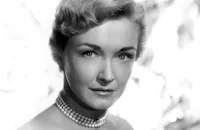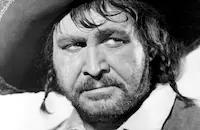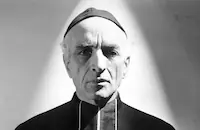Cry of the Werewolf

Brief Synopsis
Cast & Crew
Henry Levin
Nina Foch
Stephen Crane
Osa Massen
Blanche Yurka
Barton Maclane
Film Details
Technical Specs

Synopsis
At the Latour Museum in New Orleans, Louisiana, tour guide Peter Althius relates the legend of Marie Latour, the former mistress of the building, who was rumored to be a werewolf. Later that night, Yan Spavero, the janitor at the museum, visits Celeste, a gypsy princess and Marie's daughter, to warn her that Dr. Charles Morris, the museum's director, has discovered the secret behind her mother's grave and plans to publish it in a manuscript. The following day, Celeste enters the museum and disappears behind a secret panel that is embedded in the mantlepiece of a fireplace. That night, Elsa Chauvet, the doctor's Transylvanian assistant, becomes concerned when she finds a devil doll on the doctor's desk. Scoffing at the doll, which portends death, Morris asks Elsa to meet his son Bob at the airport. After Elsa departs, Peter hears unearthly screams and howls emanating from behind the mantlepiece and enters the secret passage to investigate. Upon returning to the museum with Bob, Elsa notices pages from the doctor's manuscript blazing in the fireplace, and soon after, Peter appears, lumbering in a trance. After they discover the doctor's slain body, the police are summoned and Lt. Barry Lane comes to investigate. Bob discloses that his father was researching the legend of Marie Latour, but Lane dismisses his fears about werewolves until the lab report reveals that wolf fur was found under the doctor's fingernails. Informed by the lab that a woman's hand print was also discovered on the panel door, Lane begins to suspect Elsa, but when her fingerprints fail to match those found at the murder scene, he comes to think that Yan may have been her accomplice. As Bob and Elsa piece together the charred fragments of his father's notes, Elsa voices her belief that the doctor was killed by supernatural causes. Later, as they leave the museum, Bob proposes to Elsa and she accepts. Their departure is watched by Yan, who then sneaks into the lab and destroys the remnants of the manuscript. The next day, the police discover Yan's fingerprints on the lab door and, suspecting that he is the killer, launch a manhunt to find him. Yan seeks refuge at the gypsy camp, but Celeste, fearing that his presence will jeopardize her cover as the gypsy princess, declares that he must die. When Yan's mutilated body is found, Celeste is summoned to testify at an inquiry into his death. At the hearing, Bob learns that the gypsies return to New Orleans once a year to bury their dead, who are stored at the Adamson funeral parlor. Bob then ventures to the funeral parlor, but Adamson refuses him access to the gypsies' records which are stored in the basement. Their conversation is interrupted by the arrival of the gypsies, and after Adamson excuses himself to greet his clients, Bob sneaks into the basement to examine the records. As he reaches for the files, he hears the sound of a woman's footsteps, and when the footsteps turn into the padding of a wolf, Bob escapes into the elevator. Upstairs, Bob meets Celeste, who offers to explain the customs of her people if he will escort her back to the camp. After his visit with Celeste, Bob returns to the museum, bewitched, and informs Elsa that he no longer suspects the gypsies of being involved in his father's death. Realizing that Celeste has put a spell on Bob, Elsa determines to uncover the secret of Marie Latour. Returning to the museum later that night, Elsa is confronted by Celeste, who, out of jealousy, decides to transform her rival into a sister werewolf. Later, Bob hears a cat meowing in the secret passage, and when he opens the door, a dazed Elsa appears and confesses that she killed his father. Suspecting that Celeste has cast a spell on Elsa, Bob summons the police. When Bob suggests that the basement chamber holds the secret of his father's death, Lane and several of his men descend into the passage to investigate. After locating the crypt of the gypsy queen, they hear a wolf growl and begin to fire their guns. Upstairs, Elsa awakens from her trance, and a wounded Celeste appears and incites her to kill Bob. When Bob exhorts Elsa to exercise her own will, Celeste, weakened by her wounds, turns into a wolf and attacks Bob. At that moment, the police burst into the room and slay the wolf. With the death of Celeste, the spell on Elsa is broken, and as Lane examines the body of the wolf, he begins to believe in the supernatural.

Director

Henry Levin
Cast

Nina Foch
Stephen Crane

Osa Massen
Blanche Yurka

Barton Maclane
Ivan Triesault

John Abbott
Fred Graff
John Tyrrell
Robert Williams

Fritz Leiber
Milton Parsons
Crew
Mischa Bakaleinikoff
Lionel Banks
George Brooks
Reg Browne
Milton Feldman
Griffin Jay
Griffin Jay
Wallace Macdonald
L. W. O'connell
Charles O'neal
Robert Priestley
Herman Rotsten
Dr. Fraime Sertoroclos

Videos
Movie Clip






Film Details
Technical Specs

Articles
Cry of The Werewolf - Cry of the Werewolf
Cry of the Werewolf had been intended as a direct sequel to The Return of the Vampire and bore the preproduction title Bride of the Vampire. By the time cameras rolled on May 8, 1944, the script by Griffin Jay (who had written a couple of Universal's Mummy sequels) and Charles O'Neal (fresh from penning the Val Lewton-produced The Seventh Victim [1943] at RKO) had swapped out the vampirism angle in favor of werewolfery and a trick or two cadged from Jacques Tourneur's Cat People (1942) and John Brahm's The Undying Monster (1942). Production wrapped up a day shy of three weeks with former dialogue director Henry Levin at the helm and Scarface (1932) cinematographer L. William O'Connell cloaking the proceedings in an appropriate scrim of menacing shadow. Appearing in supporting roles were Stephen Crane, then-husband of Lana Turner, and stage actress Blanche Yurka, who had played Gertrude to John Barrymore's Hamlet on Broadway in 1923.
Cry of the Werewolf had its premiere in New York in early August 1944 before being sent into theaters on its own. A critical pincushion and not nearly the money-maker that The Return of the Vampire had been, the film was swiftly withdrawn from circulation and repackaged by Columbia with Will Jason's The Soul of a Monster (1944) as the "Supernatural Double Horror Show." The bargain basement two-fer promised moviegoers that they would experience "Two Queens of Horror Explode a Double Dose of TNTerror in Your Heart." Although Cry of the Werewolf had been nobody's idea of a cash cow, Universal tendered the similar She-Wolf of London (1946) only two years later; that film's failure to generate even modest box office helped to kill the almost twenty year horror craze for good.
Born in Holland in 1924, the daughter of composer Dirk Fock and showgirl Consuelo Flowerton, Foch had pointed herself initially to careers as a painter and concert pianist. Finishing her high school equivalency at an early age and too young to proceed to college, Foch studied instead at New York's American Academy of Dramatic Arts before signing with Warner Brothers and heading to Hollywood. She made her film debut in the Warners two-reeler Wagon Wheels West (1943) before shifting allegiance to Columbia. Cry of the Werewolf did little for Foch's career, which enjoyed an uptake after her success on Broadway in 1947 in Joshua Logan's production of John Loves Mary. Back in Hollywood, she enjoyed quality roles in such films as An American in Paris (1951), Executive Suite (1954), The Ten Commandments (1956) and Spartacus (1960) and a career as a character actress and acting teacher that extended right up to her death from a blood disorder in December 2008.
Producer: Wallace MacDonald
Director: Henry Levin
Screenplay: Griffin Jay (story and screenplay); Charles O'Neal (screenplay)
Cinematography: L.W. O'Connell
Art Direction: Lionel Banks, George Brooks
Film Editing: Reg Browne
Cast: Nina Foch (Marie Latour), Stephen Crane (Robert 'Bob' Morris), Osa Massen (Elsa Chauvet), Blanche Yurka (Bianca), Barton MacLane (Lt. Barry Lane), Ivan Triesault (Jan Spavero), John Abbott (Peter Althius), Fred Graff (Pinkie), John Tyrrell (Mac), Robert Williams (Homer).
BW-63m.
by Richard Harland Smith
Sources:
Nina Foch interview by Danny Savello, Scarlet Street No. 33, 1999
Nina Foch interview by Jim Bawden, 1988
American Gothic: Sixty Years of Horror Cinema by Jonathan Rigby (Reynolds & Hearn, Ltd., 2007)

Cry of The Werewolf - Cry of the Werewolf
Quotes
Trivia
Notes
The working title of this film was Bride of the Vampire. The picture begins with the following written prologue: "The ancient belief is still held by many that anything that happens in the world is never lost. No sparrow falls unnoted-no tree crashes in the forest unheard. The sorrows, the joys, the love and the hates of past generations live on in people's memories, in their legends and their stories. Perhaps our story is something that has lived on in a person's memory or perhaps it is just a legend-" According to a Hollywood Reporter news item, Dr. Fraime Sertoroclos, a Transylvanian psychiatrist, provided technical advice for the film. This picture marked the acting debut of Stephen Crane and the directoral debut of former dialogue director Henry Levin.














